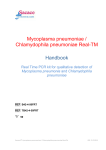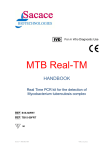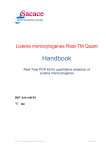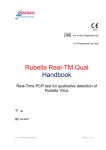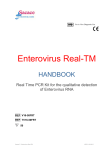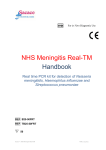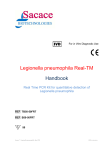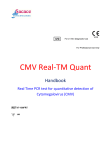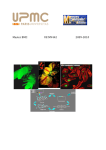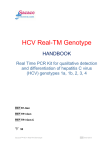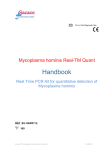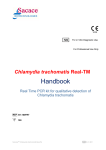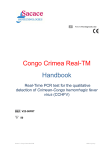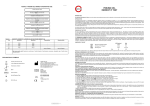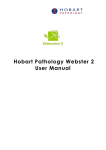Download Pneumocystis jirovecii (carinii) - bio
Transcript
IVD For in Vitro Diagnostic Use Pneumocystis jirovecii (carinii) Real-TM Handbook Real Time PCR Kit for the detection of Pneumocystis jirovecii (carinii) in biological materials REF P2-50FRT REF TP2-50FRT 50 Sacace™ Pneumocystis jirovecii (carinii) Real-TM VER 21.03.2013 NAME Pneumocystis jirovecii (carinii) Real - TM INTRODUCTION Pneumocystis pneumonia (PCP) or pneumocystosis is a form of pneumonia, caused by the yeast-like fungus (which had previously been erroneously classified as a protozoan) Pneumocystis jirovecii (carinii). P. jirovecii is now one of several organisms known to cause lifethreatening opportunistic infections in patients with advanced HIV infection worldwide. An accurate diagnosis requires access to modern medical care not available worldwide. Currently, the frequency of documented Pneumocystis infection is increasing in Africa, with Pneumocystis organisms found in up to 80% on infants with pneumonia who have HIV infection. INTENDED USE The Pneumocystis jirovecii (carinii) Real-TM is a Real-Time test for the qualitative detection of Pneumocystis jirovecii (carinii) in biological materials. PRINCIPLE OF ASSAY Kit Pneumocystis jirovecii (carinii) Real – TM is based on two major processes: DNA extracted from samples and amplification using real time amplification with fluorescent reporter dye probes specific for Pneumocystis jirovecii (carinii) and Internal Control (IC). Test contains an IC (β-globine gene) which serves as an amplification control for each individually processed specimen and to identify possible reaction inhibition. Sacace™ Pneumocystis jirovecii (carinii) Real-TM VER 21.03.2013 MATERIALS PROVIDED Module No.1: Real Time PCR kit (P2-50FRT) Part N° 2– “Pneumocystis jirovecii (carinii) Real-TM”: Real Time Amplification • PCR-mix-1 Pneumocystis jirovecii (carinii)/Glob, 0,6 ml; • PCR-buffer-FRT, 0,3 ml; • TaqF Polymerase, 0,03 ml; • Positive Control Pneumocystis jirovecii (carinii) and Human DNA C+, 0,1 ml; • Negative Control C-, 1,2 ml;* • DNA-buffer, 0,5 ml; Contains reagents for 55 tests. Module No.2: Complete Real Time PCR test with DNA purification kit (TP2-50FRT) Part N° 1 – “DNA/RNA Prep”: Sample preparation kit • Lysis Sol, 15 ml; • Prec Sol, 20 ml; • Washing Sol 3, 25,0 ml; • Washing Sol 4, 10,0 ml • RE-buffer, 4 x 1,2 ml; Contains reagents for 50 extractions Part N° 2– “Pneumocystis jirovecii (carinii) Real-TM”: • PCR-mix-1 Pneumocystis jirovecii (carinii)/Glob, 0,6 ml; • PCR-buffer-FRT, 0,3 ml; • TaqF Polymerase, 0,03 ml; • Positive Control Pneumocystis jirovecii (carinii) and Human DNA C+, 0,1 ml; • Negative Control C-, 1,2 ml;* • DNA-buffer, 0,5 ml; Contains reagents for 55 tests. *must be used in the isolation procedure as Negative Control of Extraction. Sacace™ Pneumocystis jirovecii (carinii) Real-TM VER 21.03.2013 MATERIALS REQUIRED BUT NOT PROVIDED Zone 1: sample preparation: • DNA extraction kit (Module No. 1) • Biological cabinet • Desktop microcentrifuge for “eppendorf” type tubes • 60°C ± 2°C dry heat block • Vortex mixer • Pipettors (capacity 5-40 µl; 40-200 µl; 200-1000 µl) with aerosol barrier • 1,5 ml polypropylene sterile tubes (Sarstedt, QSP, Eppendorf) • Disposable gloves, powderless • Biohazard waste container Zone 2: RT and amplification: • Desktop microcentrifuge for “eppendorf” type tubes • Vortex mixer • Disposable gloves, powderless • Biohazard waste container • Refrigerator, Freezer • Real Time Thermal cycler • Reaction tubes or plate • Workstation • Pipettes (adjustable) • Sterile pipette tips with filters • Tube racks STORAGE INSTRUCTIONS Pneumocystis jirovecii (carinii) Real-TM must be stored – 20°C. DNA/RNA Prep must be stored at 2-8°C. The kits can be shipped at 2-8°C for 3-4 days but should be immediately stored at -20°C and 2-8°C on receipt. STABILITY Pneumocystis jirovecii (carinii) Real-TM is stable up to the expiration date indicated on the kit label. The product will maintain performance through the control date printed on the label. Exposure to light, heat or humidity may affect the shelf life of some of the kit components and should be avoided. Repeated thawing and freezing of these reagents should be avoided, as this may reduce the sensitivity. QUALITY CONTROL In accordance with Sacace’s ISO 13485-Certified Quality Management System, each lot is tested against predetermined specifications to ensure consistent product quality. Sacace™ Pneumocystis jirovecii (carinii) Real-TM VER 21.03.2013 WARNINGS AND PRECAUTIONS In Vitro Diagnostic Medical Device For In Vitro Diagnostic Use Only The user should always pay attention to the following: • Lysis Solution contains guanidine thiocyanate*. Guanidine thiocyanate is harmful if inhaled, or comes into contact with skin or if swallowed. Contact with acid releases toxic gas. (Xn; R: 20/21/22-36/37/38; S: 36/37/39). • Component Prec Sol contains 2-propanol: flammable. Irritant. (R10-36-67, S7-16-24/2526). Avoid contact with skin and eyes, S26: In case of contact with eyes, rinse immediately with plenty of water and seek medical advice. • Use sterile pipette tips with aerosol barriers and use new tip for every procedure. • Store extracted positive material (samples, controls and amplicons) away from all other reagents and add it to the reaction mix in a separate area. • Thaw all components thoroughly at room temperature before starting an assay. • When thawed, mix the components and centrifuge briefly. • Use disposable gloves, laboratory coats and eye protection when handling specimens and reagents. Thoroughly wash hands afterwards. • Do not eat, drink, smoke, apply cosmetics, or handle contact lenses in laboratory work areas. • Do not use a kit after its expiration date. • Dispose of all specimens and unused reagents in accordance with local authorities’ regulations. • Specimens should be considered potentially infectious and handled in a biological cabinet in accordance with appropriate biosafety practices. • Clean and disinfect all sample or reagent spills using a disinfectant such as 0.5% sodium hypochlorite, or other suitable disinfectant. • Avoid sample or reagent contact with the skin, eyes, and mucous membranes. If skin, eyes, or mucous membranes come into contact, rinse immediately with water and seek medical advice immediately. • Material Safety Data Sheets (MSDS) are available on request. • Use of this product should be limited to personnel trained in the techniques of DNA amplification. • The laboratory process must be one-directional, it should begin in the Extraction Area and then move to the Amplification and Detection Areas. Do not return samples, equipment and reagents to the area in which the previous step was performed. Some components of this kit contain sodium azide as a preservative. Do not use metal tubing for reagent transfer. * Only for Module No.2 Sacace™ Pneumocystis jirovecii (carinii) Real-TM VER 21.03.2013 PRODUCT USE LIMITATIONS All reagents may exclusively be used in in vitro diagnostics. Use of this product should be limited to personnel trained in the techniques of DNA amplification (EN375). Strict compliance with the user manual is required for optimal PCR results. Attention should be paid to expiration dates printed on the box and labels of all components. Do not use a kit after its expiration date. SAMPLE COLLECTION, STORAGE AND TRANSPORT Pneumocystis jirovecii (carinii) Real-TM can analyze DNA extracted from: • Sputum, bronchial or tracheal lavage must be treated with the following procedure: o Collect sputum into 50 mL single-use PP tubes with a screw cap. o In a biological safety cabinet, homogenize samples after mixing with equal volume of 4% NaOH solution. (N-acetyl-L-cysteine may be added if required in the amount of 50-70 mg per sample). Mix intensely with a tube rotator for 5-20 minutes (depending on the density of a sample). o Centrifuge samples at 3000 rpm (2800-3000 g) for 15 min and carefully discard the supernatant leaving 500-1000 µl in the tube. Resuspend sediment and transfer it into a 1.5 ml tube. o Centrifuge samples at 12000 rpm for 5-10 min, discard the supernatant and use the same 1,5 ml sample tube for DNA isolation from sample sediment. • bronchial lavage: centrifuge 10 mL at 7000 g/min for 10-15 min. Remove and discard the supernatant. If the pellet isn’t visible add 10 ml of liquid and repeat centrifugation remove and discard the supernatant. Resuspend the pellet in 100 µl of saline water. • tissue (~1,0 gr) homogenized with mechanical homogenizer or scalpel, glass sticks, teflon pestles and dissolved in 1,0 ml of saline water or PBS sterile (1 volume of tissue to 1 volumes of saline solution). Vortex vigorously and incubate 30 min at room temperature. Transfer the supernatant into a new 1,5 ml tube; • swabs: insert the swab into the nuclease-free 1,5 ml tube and add 0,2 mL of Transport medium. Vigorously agitate swabs in medium for 15-20 sec. It is recommended to process samples immediately after collection. Store samples at 2–8 °C for no longer than 24 hours, or freeze at –20/80°C. Transportation of clinical specimens must comply with country, federal, state and local regulations for the transport of etiologic agents. DNA ISOLATION The following kit is recommended: DNA/RNA Prep (Sacace, REF K-2-9) Please carry out DNA extraction according to the manufacture’s instruction. Sacace™ Pneumocystis jirovecii (carinii) Real-TM VER 21.03.2013 SPECIMEN AND REAGENT PREPARATION (reagents supplied with the module no.2) 1. Prepare required number of 1.5 ml disposable polypropylene micro centrifuge tubes including one tube for Negative Control of Extraction (Negative Control, NCE). N.B. if the sample is sputum, use the same 1,5 ml sample tube obtained from sputum preparation procedure (see SAMPLE COLLECTION, STORAGE AND TRANSPORT). 2. Add to each tube 300 µl of Lysis Sol 3. Add 100 µl of samples to the appropriate tubes using pipette tips with aerosol barriers. 4. Prepare Controls as follows: o add 100 µl of NCE to the tube labeled Cneg 5. Vortex the tubes and incubate for 5 min at 65°C. Centrifuge for 7-10 sec. 6. Add 400 µl of Prec Sol and mix by vortex. Centrifuge all tubes at 13,000 r/min for 5 min and using a micropipette with a plugged aerosol barrier tip, carefully remove and discard supernatant from each tube without disturbing the pellet. Change tips between the tubes. 7. Add 500 µl of Wash Sol 3 into each tube. Vortex vigorously to ensure pellet washing. Centrifuge all tubes at 13,000 r/min for 60 sec and using a micropipette with a plugged aerosol barrier tip, carefully remove and discard supernatant from each tube without disturbing the pellet. Change tips between the tubes. 8. Add 200 µl of Wash Sol 4 into each tube. Vortex vigorously to ensure pellet washing. Centrifuge all tubes at 13,000 r/min for 60 sec and using a micropipette with a plugged aerosol barrier tip, carefully remove and discard supernatant from each tube without disturbing the pellet. Change tips between the tubes. 9. Incubate all tubes with open caps at 65 °C for 5 min. 10. Resuspend the pellet in 50 µl of RE-buffer (elution volume can be increased up to 90 µl). Incubate for 5 min at 65°C and vortex periodically. 11. Centrifuge the tubes at 13000g for 60 sec. The supernatant contains RNA/DNA ready for amplification. If amplification is not performed the same day of extraction, the processed samples can be stored at 2-8°C for at maximum period of 5 days or frozen at - 20°/-80°C. Sacace™ Pneumocystis jirovecii (carinii) Real-TM VER 21.03.2013 PROTOCOL (Reaction volume 25 µl): 1. Prepare Mix of PCR-buffer-FRT and TaqF Polymerase by adding 30 µl of TaqF Polymerase in the tube with PCR-buffer-FRT. This mix is stable for 3 months at + 2-8°C. If you don’t need to use the all volume in 3 months, it is possible to prepare a lower quantity of Mix of PCR-buffer-FRT and TaqF Polymerase at the rate of 10 to 1, (for example 150 µl of PCR-buffer-FRT and 15 µl of TaqF Polymerase). 2. Prepare required quantity of reaction tubes for samples and controls and add for each tube 10 µl of PCR-mix-1 and 5 µl of Mix (PCR-buffer-FRT with TaqF Polymerase). 3. Add 10 µl of extracted DNA sample to appropriate tube. (Re-centrifuge all the tubes with extracted DNA for 2 min at maximum speed (12000-16000 g) and take carefully supernatant. N.B. don’t disturb the pellet, sorbent inhibit reaction!). 4. Prepare for each panel 2 controls: • add 10 µl of DNA-buffer to the tube labeled Amplification Negative Control (NCA); • add 10 µl of Pneumocystis jirovecii (carinii) and Human DNA C+ to the tube labeled. C+; The results are interpreted through the presence of crossing of fluorescence curve with the threshold line. β-globine gene (IC) is detected on the FAM (Green) channel, Pneumocystis jirovecii (carinii) on the JOE (Yellow)/HEX/Cy3 channel. AMPLIFICATION 1. Create a temperature profile on your instrument as follows: Rotor-type Instruments1 Step 1 2 3 Тemperature, °С 95 95 60 72 95 60 72 Plate- or modular type Instruments2 Time Repeats 15 min 5s 20 s 15 s 5s 20 s fluorescent signal detection 15 s 1 5 40 Тemperature, °С 95 95 60 72 95 60 72 Time Repeats 15 min 5s 20 s 15 s 5s 30 s fluorescent signal detection 15 s 1 1 5 40 For example Rotor-Gene™ 3000/6000/Q (Corbett Research, Qiagen) 2 For example, SaCycler-96™ (Sacace), iQ5™ (BioRad); Mx3005P™ (Agilent), ABI® 7300/7500/StepOne Real Time PCR (Applied), SmartCycler® (Cepheid), LineGeneK® (Bioer) Sacace™ Pneumocystis jirovecii (carinii) Real-TM VER 21.03.2013 INSTRUMENT SETTINGS Rotor-type instruments (RotorGene 3000/6000, RotorGene Q) Channel Threshold FAM/Green JOE/Yellow 0.03 0.03 More Settings/ Outlier Removal 10 % 10 % Slope Correct On On Plate-type instruments The threshold line should cross only sigmoid curves of signal accumulation of positive samples and should not cross the baseline; otherwise, the threshold level should be raised. Set the threshold at a level where fluorescence curves are linear and do not cross curves of the negative samples. DATA ANALYSIS Pneumocystis carinii DNA amplification product is detected in the JOE/Yellow/HEX channel, Internal Control - β-globine gene amplification product is detected in the FAM/Green channel. The results are interpreted by the software of the PCR instrument by the crossing (or not crossing) of the fluorescence curve with the threshold line. The analysis results are considered valid, only if the control samples results comply with the following: Results for controls Control Stage for control NCE NCA C+ DNA extraction Amplification Amplification Ct in channel FAM/Green ≤ 35 Neg ≤ 35 JOE/Yellow/HEX Neg Neg ≤33 Interpretation OK OK OK 1. The sample is considered positive if Ct values detected in the FAM/Green and JOE/Yellow/HEX channel are less than the boundary Ct values (≤ 38) for these channels. The fluorescence curve should have a typical sigmoid shape and cross the threshold line in the region of significant fluorescence increase only once. 2. The sample is considered negative if its fluorescence curve does not cross the threshold line (Ct value is absent) and does not have the typical shape. The results of analysis are considered reliable only if the results obtained for Positive and Negative Controls of Amplification as well as for the Negative Control of Extraction are correct. Sacace™ Pneumocystis jirovecii (carinii) Real-TM VER 21.03.2013 QUALITY CONTROL PROCEDURE A defined quantity of Internal Control (IC) is introduced into each sample and control at the beginning of sample preparation procedure in order to control the extraction process of each individual sample and to identify possible reaction inhibition. A negative control of extraction (NCE), negative amplification control (NCA), positive amplification control (C+) are required for every run to verify that the specimen preparation, the amplification and the detection steps are performed correctly. If the controls are out of their expected range (see table Results for Controls), all of the specimens and controls from that run must be processed beginning from the sample preparation step. PERFORMANCE CHARACTERISTICS Sensitivity The analytical sensitivity of Pneumocystis carinii Real-TM PCR kit is 200 Pneumocystis carinii DNA copies/ml. The claimed analytical features of Pneumocystis carinii Real-TM PCR kit are guaranteed only when additional reagent kit (DNA/RNA-prep) is used. Specificity The analytical specificity of Pneumocystis carinii Real-TM PCR kit is ensured by selection of specific primers and probes as well as stringent reaction conditions. The primers and probes were checked for possible homologies to all sequences published in gene banks by sequence comparison analysis. The clinical specificity of Pneumocystis carinii Real-TM PCR kit was confirmed in laboratory clinical tests. Sacace™ Pneumocystis jirovecii (carinii) Real-TM VER 21.03.2013 TROUBLESHOOTING 1. Weak or absent signal of the IC (Fam/Green): retesting of the sample is required. • The PCR was inhibited. ⇒ Make sure that you use a recommended DNA extraction method and follow the manufacturer’s instructions. ⇒ Re-centrifuge all the tubes before pipetting the extracted DNA for 2 min at maximum speed (12000-16000 g) and take carefully supernatant. • The reagents storage conditions didn’t comply with the instructions. ⇒ Check the storage conditions • The PCR conditions didn’t comply with the instructions. ⇒ Check the PCR conditions and for the IC detection select the fluorescence channel reported in the protocol. • Improper DNA extraction. ⇒ Repeat analysis starting from the DNA extraction stage ⇒ Make attention during the DNA extraction procedure. 2. Weak (Ct > 38) signal on the Joe (Yellow)/Cy3/HEX channel: the result is considered equivocal. It is necessary to repeat the analysis twice. If a positive Ct value is detected twice, the sample is considered as positive. 3. Joe (Yellow)/Cy3/HEX signal with Negative Control of extraction. • Contamination during DNA extraction procedure. All samples results are invalid. ⇒ Decontaminate all surfaces and instruments with sodium hypochlorite and ethanol. ⇒ Use only filter tips during the extraction procedure. Change tips among tubes. ⇒ Repeat the DNA extraction with the new set of reagents. 4. Any signal with Negative PCR Control. • Contamination during PCR procedure. All samples results are invalid. ⇒ Decontaminate all surfaces and instruments with sodium hypochlorite and ethanol or special DNA decontamination reagents. ⇒ Pipette the Positive controls at the end. ⇒ Repeat the PCR preparation with the new set of reagents. Sacace™ Pneumocystis jirovecii (carinii) Real-TM VER 21.03.2013 KEY TO SYMBOLS USED List Number Caution! Lot Number Contains sufficient for <n> tests For in Vitro Diagnostic Use Version Store at NCA Negative Control of Amplification Manufacturer C– Negative control of Extraction Consult instructions for use C+ Positive Control of Amplification Expiration Date IC Internal Control * SaCycler™ is a registered trademark of Sacace Biotechnologies *iQ5™ is a registered trademark of Bio-Rad Laboratories * Rotor-Gene™ Technology is a registered trademark of Qiagen * MX3005P® is a registered trademark of Agilent Technologies *ABI® is a registered trademark of Applied Biosystems * LineGeneK® is a registered trademark of Bioer * SmartCycler® is a registered trademark of Cepheid Sacace Biotechnologies Srl via Scalabrini, 44 – 22100 – Como – Italy Tel +390314892927 Fax +390314892926 mail: [email protected] web: www.sacace.com Sacace™ Pneumocystis jirovecii (carinii) Real-TM VER 21.03.2013












